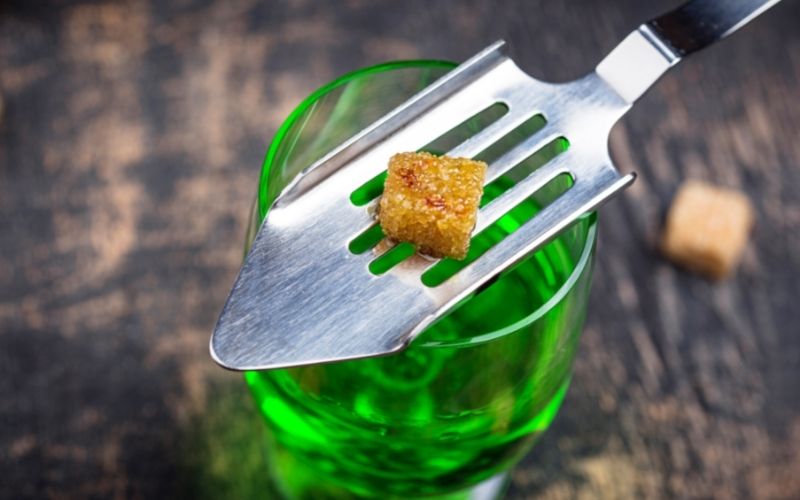
The Ultimate Guide On How To Use An Absinthe Spoon


Absinthe is a mystifying drink that has been shrouded in mystery for centuries. It's time to set the record straight and learn how to use an absinthe spoon so you can enjoy this intriguing beverage properly.
The following article will provide an in-depth guide on using an absinthe spoon and its various types, including correctly putting the sugar cube and water needed for a traditional French absinthe ritual.
Here’s a video showing how to serve absinthe using an absinthe spoon:

People in the nineteenth century had a sweet palate. Bitter tastes did not appeal to many people. As a result, it became clear very quickly that sugar must be added to Absinthe.
However, sugar does not react chemically with alcohol, which is the main component of Absinthe. To reduce the percentage of alcohol, you must add water for the sugar to dissolve.
As you might expect, simply pouring water into an Absinthe glass might not be the most elegant activity on the planet. This is why the ceremony known as the "Classic French Absinthe Ritual" was created.
It is a more complicated manner of pouring water into the glass. Fill the glass with Absinthe, put an Absinthe spoon, place a sugar cube on it, and pour water. Because the water is added slowly, drop by drop, the louche of your Absinthe becomes thicker.
Absinthe spoons were available as early as the 1840s. However, their widespread usage coincided with the rise in Absinthe consumption during the last third of the 19th century.
The spoons were fashioned from various materials, including silver, copper, nickel, and aluminum. The Eiffel Tower Absinthe Spoon is a well-known late 19th-century spoon. It is shaped after the Eiffel Tower and was created for the building's opening in 1889.

Types of Absinthe Spoons - Image by kudosprs.com
A few historians have varying opinions regarding the different kinds of absinthe spoons. However, one of the most prominent French absinthe historians named David Nathan-Maister from Great Britain states that there are 6 types of absinthe spoons.
The six divisions of absinthe spoons are written in his book titled "The Absinthe Encyclopedia" and are based on his knowledge of the Belle Epoque.

As the name implies, these are spoons that have perforations. Technically speaking, perforations are defined as holes in solid materials caused by piercing the object.
For absinthe spoons, the perforations allow the placed sugar cube to flow off into the glass once diluted. Whether the sugar is diluted with water or ignited, the absinthe spoon would do the trick. As such, these are the most common and used types of absinthe spoon.

Originating in Switzerland, they are also known as "Les Rondes" (the rounds). These spoons have one thing in common: they are all relatively symmetrical. Most of the time, three identical legs lay on the edge of the absinthe glass, positioning the middle part symmetrically in the center.
The sugar cube to be diluted is placed in the center of the spoon. The spoon's design will prevent it from dripping down the side. Flower blossoms, snowflakes, skeletons, and gothic mystical symbols are some examples of "Grilles" shapes.

Long Absinthe Spoons - Image by kegworks.com
Long absinthe spoons are another variety that is becoming increasingly rare in the absinthe realm today. The sugar cube is usually put in the center of the whole length of this spoon.
This contrasts to traditional spoons, which have the sugar placed at the upper end of the entire spoon length. As the name suggests, Long Absinthe spoons are ideal for Absinthe glasses with wide mouths, as the diameter on which the spoon sits can also be much greater.
Thus, on huge glasses, the sugar piece can be placed in the center by simply rotating the spoon over and having the central sugar tray in the proper position.

The Eiffel Tower Spoons are absinthe spoons shaped after the Eiffel Tower. These absinthe spoons were first created in 1889 during the "Exposition Universelle" in Paris to commemorate the Eiffel Tower.
There are numerous versions that each recreate this form in their own unique way. It is challenging to distinguish between an original spoon from this era and other imitation spoons.
Only absolute famous Absinthe experts, traders, or art historians will be able to tell the difference between genuine and counterfeit Eiffel Tower Absinthe spoons.
However, not every Absinthe aficionado will want such costly original spoons and be willing to spend such a large sum of money. Especially since many copies on the market today look the same and may be used to commemorate your absinthe ritual.

Wormwood branch absinthe spoons are another type of spoons. These spoons highlight the "Artemisia Absinthium" (wormwood) in the appearance of wormwood branches or wormwood leaves, which are frequently elegantly branched.
One can say that these are the most stunning Absinthe spoons available as authentic copies right now. Simply lay the sugar on the wormwood leaf and immerse yourself in the magical realm of Absinthe.
These Absinthe spoons are more or less branching and thus more stable. By selecting the appropriate spoon, each Absinthe drinker can fulfill their own personal taste.

The word "Poilu" is derived from the nicknames of French troops during World War I. A "Poilu" was a soldier or, more colloquially, a compatriot in German.
Poilu actually means "hairy." When it came to the soldiers, it was natural that they didn't have time to shave if they had to wait in the trenches for an extended period. But there was still time for another pastime.
Making absinthe spoons out of scrap metal, such as that from grenades or explosions. The so-called "Poilu" Absinthe Spoons were made during long times of waiting between battles in soldiers' trenches and were a sought-after keepsake for family or loved ones back home.
Poilu spoons were sometimes created from leftover materials from everyday household things such as inkpots, vases, or even knives, which were pierced out to allow the sugar to pour into the absinthe glass.
Absinthe spoons are essential to enjoy drinking Absinthe. We hope this blog post has answered all of your questions about them.
If you want to learn more about the green fairy, check out our blog for even more information on the topic!

